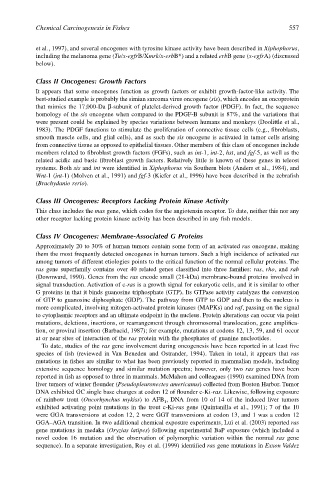Page 577 - The Toxicology of Fishes
P. 577
Chemical Carcinogenesis in Fishes 557
et al., 1997), and several oncogenes with tyrosine kinase activity have been described in Xiphophorus,
including the melanoma gene (Tu/x-egfrB/Xmrk/x-erbB*) and a related erbB gene (x-egfrA) (discussed
below).
Class II Oncogenes: Growth Factors
It appears that some oncogenes function as growth factors or exhibit growth-factor-like activity. The
best-studied example is probably the simian sarcoma virus oncogene (sis), which encodes an oncoprotein
that mimics the 17,000-Da β-subunit of platelet-derived growth factor (PDGF). In fact, the sequence
homology of the sis oncogene when compared to the PDGF-B subunit is 87%, and the variations that
were present could be explained by species variations between humans and monkeys (Doolittle et al.,
1983). The PDGF functions to stimulate the proliferation of connective tissue cells (e.g., fibroblasts,
smooth muscle cells, and glial cells), and as such the sis oncogene is activated in tumor cells arising
from connective tissue as opposed to epithelial tissues. Other members of this class of oncogenes include
members related to fibroblast growth factors (FGFs), such as int-1, int-2, hst, and fgf-5, as well as the
related acidic and basic fibroblast growth factors. Relatively little is known of these genes in teleost
systems. Both sis and int were identified in Xiphophorus via Southern blots (Anders et al., 1984), and
Wnt-1 (int-1) (Molven et al., 1991) and fgf-3 (Kiefer et al., 1996) have been described in the zebrafish
(Brachydanio rerio).
Class III Oncogenes: Receptors Lacking Protein Kinase Activity
This class includes the mas gene, which codes for the angiotensin receptor. To date, neither this nor any
other receptor lacking protein kinase activity has been described in any fish models.
Class IV Oncogenes: Membrane-Associated G Proteins
Approximately 20 to 30% of human tumors contain some form of an activated ras oncogene, making
them the most frequently detected oncogenes in human tumors. Such a high incidence of activated ras
among tumors of different etiologies points to the critical function of the normal cellular proteins. The
ras gene superfamily contains over 40 related genes classified into three families: ras, rho, and rab
(Downward, 1990). Genes from the ras encode small (21-kDa) membrane-bound proteins involved in
signal transduction. Activation of c-ras is a growth signal for eukaryotic cells, and it is similar to other
G proteins in that it binds guanosine triphosphate (GTP). Its GTPase activity catalyzes the conversion
of GTP to guanosine diphosphate (GDP). The pathway from GTP to GDP and then to the nucleus is
more complicated, involving mitogen-activated protein kinases (MAPKs) and raf, passing on the signal
to cytoplasmic receptors and an ultimate endpoint in the nucleus. Protein alterations can occur via point
mutations, deletions, insertions, or rearrangement through chromosomal translocation, gene amplifica-
tion, or proviral insertion (Barbacid, 1987); for example, mutations at codons 12, 13, 59, and 61 occur
at or near sites of interaction of the ras protein with the phosphates of guanine nucleotides.
To date, studies of the ras gene involvement during oncogenesis have been reported in at least five
species of fish (reviewed in Van Beneden and Ostrander, 1994). Taken in total, it appears that ras
mutations in fishes are similar to what has been previously reported in mammalian models, including
extensive sequence homology and similar mutation spectra; however, only two ras genes have been
reported in fish as opposed to three in mammals. McMahon and colleagues (1990) examined DNA from
liver tumors of winter flounder (Pseudopleuronectes americanus) collected from Boston Harbor. Tumor
DNA exhibited GC single base changes at codon 12 of flounder c-Ki-ras. Likewise, following exposure
of rainbow trout (Oncorhynchus mykiss) to AFB , DNA from 10 of 14 of the induced liver tumors
1
exhibited activating point mutations in the trout c-Ki-ras gene (Quintanilla et al., 1991); 7 of the 10
were GGA transversions at codon 12, 2 were GGT transversions at codon 13, and 1 was a codon 12
GGA–AGA transition. In two additional chemical exposure experiments, Lui et al. (2003) reported ras
gene mutations in medaka (Oryzias latipes) following experimental BaP exposure (which included a
novel codon 16 mutation and the observation of polymorphic variation within the normal ras gene
sequence). In a separate investigation, Roy et al. (1999) identified ras gene mutations in Exxon Valdez

